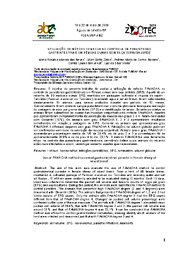Utilização do método FAMACHA no controle de parasitoses gastrintestinais em fêmeas ovinas Sem raça definida (SRD).
Utilização do método FAMACHA no controle de parasitoses gastrintestinais em fêmeas ovinas Sem raça definida (SRD).
Author(s): NEVES, M. R. M. das; ZAROS, L. G.; NAVARRO, A. M. do C.; BENVENUTI, C. L.; VIEIRA, L. da S.
Summary: Resumo: O objetivo do presente trabalho foi avaliar a utilização do método FAMACHA, no controle de parasitoses gastrintestinais em fêmeas ovinas sem raça definida (SRD). A partir de um rebanho de 90 matrizes ovinas SRD, mantidas em pastagem cultivada e irrigada de capim-Tanzânia (Panicum maximum cv. Tanzânia), recebendo água e sal ad libitum, foram selecionados aleatoriamente 15 animais para serem avaliados durante um período de 12 meses. Quinzenalmente foram coletado sangue para determinar o volume globular e fezes para realização da contagem de ovos por grama de fezes (OPG) e a identificação de larvas. Durante as coletas os animais foram submetidos ao exame das mucosas conjuntivas pelo método FAMACHA. Aqueles que apresentaram comprometimento da coloração da mucosa nos graus 3 e 4 foram medicados com Closantel (10%). Os animais com grau FAMACHA 1, 2 e 3 apresentaram resultados semelhantes em relação a contagem de OPG. Somente os animais que apresentaram grau FAMACHA 1 diferiram daqueles com grau FAMACHA 4. Alterações no volume globular puderam ser confirmadas com base na coloração da mucosa conjuntival. Animais com o grau FAMACHA 1 apresentaram porcentagem média de VG de 29,4%, os de grau 2 e 3 a porcentagem foi de aproximadamente 26,0% e os de grau 4 foi de 23,1%. O método FAMACHA é uma ferramenta eficaz no controle das parasitoses gastrintestinais, permitindo definir quais animais do rebanho estão mais infectados e assim, vermifugar somente aqueles que necessitarem. Abstract: The aim of this work was evaluate the use of FAMACHA method to control gastrointestinal parasite in female sheep of mixed breed. From a herd of 90 female sheep, maintained in cultivated pastage of Panicum maximum cv. Tanzânia and receiving water and salt ad libutum, 15 of them were randomly selected to be evaluated during 12 months. Each 15 days, blood was collected to determine the packed cell volume and feces to counts of eggs per gram (EPG) and coprocultures. During this period, the animals were submitted to FAMACHA method to control parasites. The animals that presented high FAMACHA degree (3 and 4 degrees) were dewormed with Closantel (10%). The animals that presented FAMACHA degree of 1, 2 and 3 had similar means of EPG counts. Only the animals with FAMACHA degree 1, had the EPG counts different from that of FAMACHA degree 4. Changes on packed cell volume percentage were confirmed by the color of the eye mucosae. The animals with FAMACHA degree 1 presented mean packed cell volume of 29,4%, that with FAMACHA degree 2 and 3, the packed cell volume was around 26%, and that of FAMACHA degree 4 was 23,1%. It can be concluded that FAMACHA method was efficient to control gastrointestinal nematodes, allowing identify which animals of the herd were infected and dewormed just that with FAMACHA degree 3 and 4.
Publication year: 2009
Types of publication: Paper in annals and proceedings
Unit: Embrapa Goats & Sheep
Observation
Some of Embrapa's publications are published as ePub files. To read them, use or download one of the following free software options to your computer or mobile device. Android: Google Play Books; IOS: iBooks; Windows and Linux: Calibre.
Access other publications
Access the Agricultural Research Database (BDPA) to consult Embrapa's full library collection and records.
Visit Embrapa Bookstore to purchase books and other publications sold by Embrapa.

